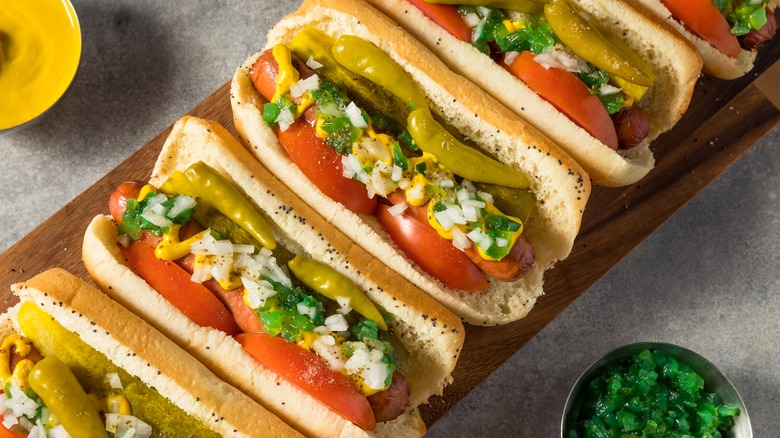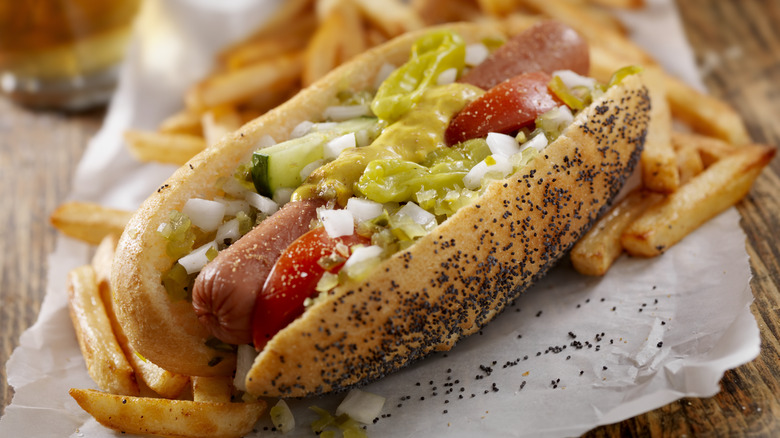What Makes Chicago Hot Dogs Different?
At first glance, a hot dog might seem like a simple street food or barbecued meat, but in actuality, there are upwards of 40 ways the world makes awesome hot dogs — and all of them are unique in their own way. One regional hot dog style that stands out for its pop of flavors, appearance, and textures hails from Chicago. What makes a Chicago hot dog different from the rest? Its inclusion of crunchy veggie toppings and brightly colored condiments.
Chicago's signature frankfurter is often referred to as 'dragged through the garden' because it is literally piled high with veggies. This style of dog is said to have been created to bulk up the links with healthy ingredients during the Great Depression. And its heartiness delivers — when you order a hot dog in Chi-Town, you can expect the frank to be topped with bright yellow mustard, greener-than-the-garden pickle relish, and chopped onion.
Then, it's wedged with tomatoes and pickle spears on either side between the dog and the bun, and completed with pickled sport peppers (also a regional favorite) and celery salt. The result is a full-on meal when you bite into the all-beef hot dog, perfectly steamed or charred and stacked on its signature pillowy steamed poppyseed bun.
The Chicago dog was created to be filling and cheap
The Windy City is well-known for its quality regional dishes, including Chicago-style pizza and its beloved frankfurters. The Chicago hot dog, also known as the 'Depression sandwich,' was originally created to feed working-class people for as cheap as a nickel. A famed and long-lost establishment called Fluky's was the first to sell the veggie-piled frank complete with mustard, lettuce, tomato, onions, and pickle relish. What followed was the garden dog's tasty popularity largely thanks to the need to find creative and affordable ways to fill people up fast.
The influx of this hearty hot dog rendition built upon the Windy City's already thriving meat and food production industry. A rich history of German immigration to the state had already put hot dogs on the map, and by the time the Depression sandwich came around, the Vienna Beef company (started in 1893) became a key component of the classic sandwich. The Vienna Beef sign used by many stands and shops to this day indicates that the all-beef Polish sausage brand still is the weiner of choice for purveyors of the Chicago hot dog.
The regional specialty has evolved since its inception
Though some say not to mess with tried-and-true food traditions, along with the city's growing food scene, Chicago hot dogs have evolved past their working-class origins. Today, you'll be hard-pressed to find lettuce on the dog. There are some steadfast rules like never including ketchup, but otherwise, there's usually room for interpretation. For instance, what began as a simple and filling dog served with no sides now is often accompanied by an order of fries. Certain shops like Gene & Jude's in the suburbs even serve up the dog with spuds piled directly onto the bun.
When it comes to questions like whether the frank is best steamed or charred, some shops prefer steamed to achieve the perfect snappy bite. Then there are others, like Fatso's Last Stand, who are famous for their signature charred version.
Other institutions, like Jim's Original, go as far as to grill the onions for their Polish Sausage Sandwich. Today, some gourmet restaurants in the city are taking homemade hot dogs to a whole new level by mixing different types of meat into the sausage or adding inventive toppings. You can order plant-based versions that take the 'garden' in 'garden dog' seriously, like the Veggie Lover at Devil Dawgs. However your hot dog is prepared, if it's Chicago-style, it will be piled high with brightly colored and crisp vegetable toppings.



